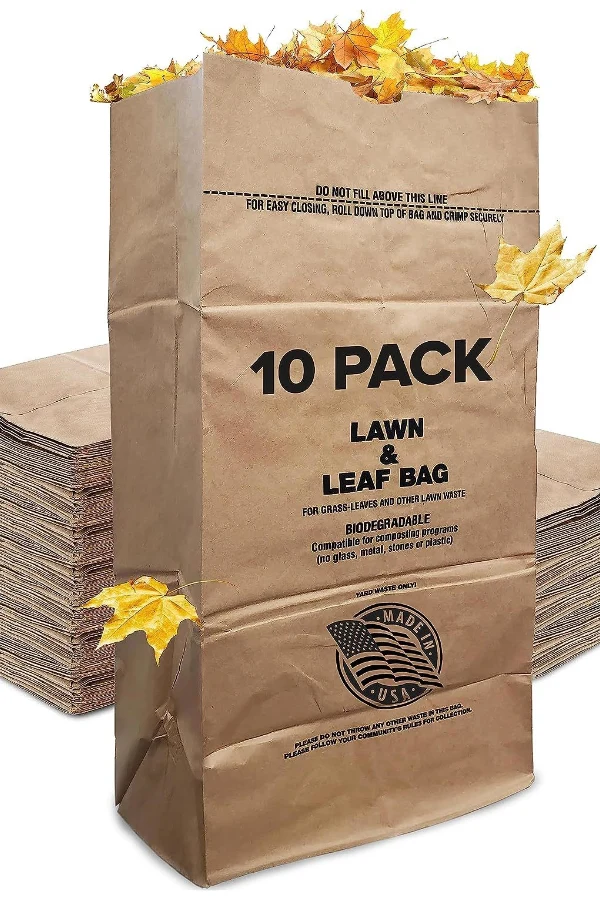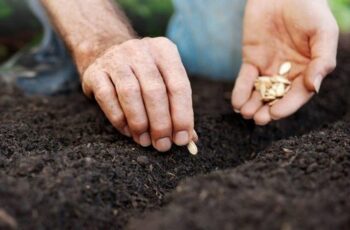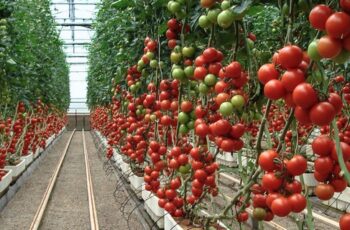Ad Blocker Detected
Our website is made possible by displaying online advertisements to our visitors. Please consider supporting us by disabling your ad blocker.
It may sound crazy, but what you do with your tomato plants as they die off in the fall can have a big impact on how well your tomato plants and other vegetables grow next year.
One of the most important things a gardener can do in the fall is to clear away their vegetable plants as they die off, especially in a traditional garden, raised bed, or container garden. The faster you do this, the better!
Leaving decaying plants in your garden is a quick way to create a lot of problems for next year. As plants break down, they become breeding grounds for mold, mildew, and disease. They also attract and provide food and shelter for a long list of garden pests.
So what should you do with your dead tomato plants? If you have a compost pile, you can add them to that. But be sure to remove any diseased plants, as these can spread disease to other plants in your compost pile.
If you don’t have a compost pile, you can dispose of your dead tomato plants in the trash. But be sure to bag them securely to prevent pests from spreading.
By clearing away your dead tomato plants in the fall, you can help to ensure a healthy and productive vegetable garden next year.
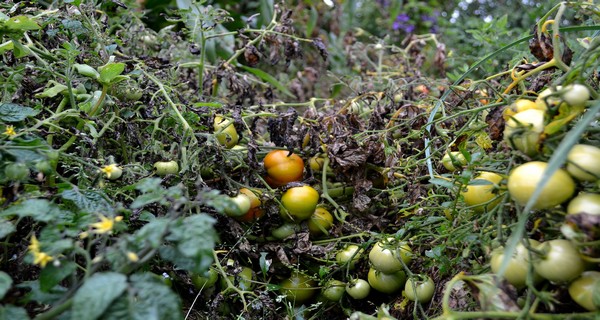
The longer a dying tomato plant stays in the ground, the more danger it brings to other plants and the surrounding soil. Not just for this year’s garden crops – but more importantly, next year!
Leaving dying tomato plants in your garden can put your next year’s crop at risk. Tomato plants are especially susceptible to pests and diseases, and leaving them to decompose can create a breeding ground for these problems.
The Dangers Of Leaving Tomato Plants In The Garden – How To Dispose Of Tomato Plants After They Die Off
Tomato plants are highly susceptible to disease and pests. The longer the plants are left in the garden, the more likely they are to become infected and spread disease to other plants, including the surrounding soil.
One of the most serious diseases that can affect tomato plants is blight, a soil-borne disease that can live in the soil for years. As infected foliage and fruit fall, they drop spores onto the soil surface, which can then infect future tomato crops.
Rotting tomato plants also attract pests and insects, such as tomato hornworms, aphids, and tomato root nematodes. These pests can lay eggs on the plants, which can hatch and come back to haunt next year’s crop.
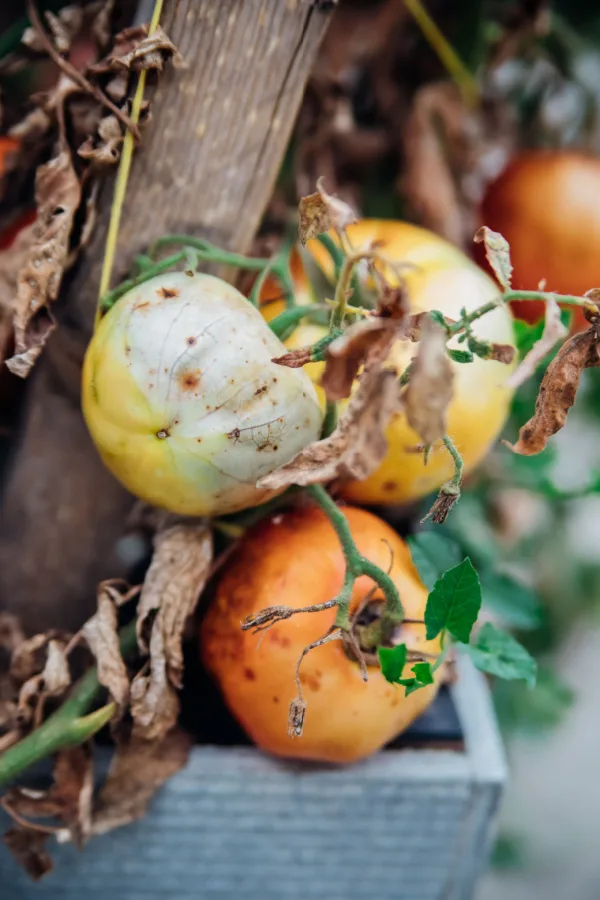 Rotting tomatoes are a major attraction to insects and pests. The longer they stay on the vines and in the garden, the more they attract.
Rotting tomatoes are a major attraction to insects and pests. The longer they stay on the vines and in the garden, the more they attract.
It’s obvious to see how important it is to get your old tomato plants out of their growing space as they begin to die off. But here’s the kicker – you also have to be careful with the plants once you take them out!
Here are some safety tips for handling dying tomato plants:
- Wear gloves and long sleeves to protect yourself from thorns and other sharp objects.
- Be careful not to inhale any dust or spores from the plants, as these can cause respiratory problems.
- Wash your hands thoroughly after handling dying tomato plants.
In addition to these general safety tips, there are a few specific things to keep in mind when disposing of dying tomato plants:
- If you have a compost pile, you can add your dead tomato plants to it. However, be sure to remove any diseased plants, as these can spread disease to other plants in the compost pile.
- If you don’t have a compost pile, you can dispose of your dead tomato plants in the trash. However, be sure to bag them securely to prevent pests from spreading.
- You can also burn your dead tomato plants, but be sure to check with your local fire department first to make sure that it is safe to do so.
By following these safety tips, you can help protect yourself and your garden from pests and diseases.
Bonus creative tip: If you have any friends or neighbors who are interested in starting their own tomato garden, you can offer to give them your dead tomato plants. They can be used as mulch for new tomato plants, which can help to suppress weeds and retain moisture. Just be sure to let them know that they should remove any diseased plants before using them as mulch.
How To Dispose Of Tomato Plants After They Die Off
When it comes to dealing with your old tomato plants and decaying fruit, it’s crucial to steer clear of adding them to your household compost heap.
For the majority of crops you clear out of your garden in the autumn, the compost pile proves to be the ideal destination. These plants decompose, returning their remaining nutrients and contributing to the creation of exceptional compost. This valuable compost can then be employed the following year to nourish a fresh garden with new plants.
Take vegetable crops like beans, greens, and peas, for instance. They not only supply rich foliage that breaks down quickly, but they’re also packed with nutrients. Furthermore, they pose little risk of introducing diseases to your compost pile.
However, tomato plants present a different scenario. Due to the likelihood of harboring diseases, it’s best to keep them far away from your household compost heap. To effectively neutralize blight spores and other harmful pathogens, a compost pile needs to reach exceptionally high temperatures for an extended period.
Regrettably, the compost bins and piles commonly found in households lack the size, ventilation, and ingredients necessary to achieve those critical temperatures. Consequently, the pathogens persist. When the final compost is used in the subsequent year, it ends up infecting other plants as well.
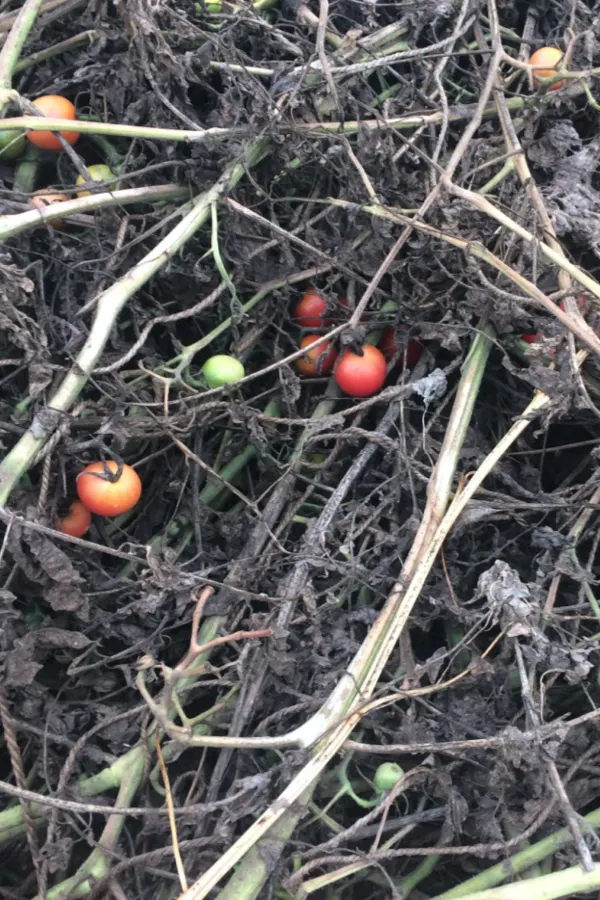 It’s never a good idea to add tomato plants and rotting tomatoes to your home compost pile.
It’s never a good idea to add tomato plants and rotting tomatoes to your home compost pile.
Leave The Tomatoes Out Too! How To Dispose Of Tomato Plants After They Die Off
So, why exclude those decomposing tomato fruits? Well, to begin with, they can harbor blight spores, mildew, and other potential health hazards for your compost pile. What’s more, it’s wise to leave them out to prevent volunteer seeds from becoming a nuisance in the upcoming growing season.
Just like with the pathogens, a home compost pile doesn’t generate enough heat to eliminate the seeds within tomato fruits. A single tomato can house hundreds of tiny seeds. Once these seeds pass through the compost, they’ll sprout wherever the compost is used, creating a weeding issue for the next year.
Given all these risks, what’s the safest approach for handling old tomato plants and fruit? Clearly, the first step is to keep them as far from your garden area as possible.
However, simply tossing them in your regular trash feels like a missed opportunity. Especially when you consider that this leads to unnecessary waste in landfills, disposing of materials that still hold value. Bearing this in mind, here are three excellent alternatives:
3 Great Ways To Dispose Of Tomato Plants After They Die
#1 Trench & Bury Method
Even though it’s advised not to incorporate tomatoes into your household compost pile, it doesn’t mean you can’t still compost them. After all, like any living plants, they contribute essential minerals and nutrients back to the soil as they decompose. This is precisely where trench composting comes into play!
Trench composting proves to be an excellent method for composting a variety of materials, especially if you don’t have a dedicated compost pile. And the best part? It’s incredibly straightforward. Essentially, all you need to do is dig a deep hole and bury the plant material. The plants will naturally break down and enrich the soil with their resources.
While you can perform this process with non-tomato materials anywhere in your garden, it’s crucial to bury tomato materials away from your garden area. This practice ensures the safety of your garden and provides a convenient way to dispose of your tomato plants!
Community / Commercial Composting Centers – What To Do With Tomato Plants When They Die
Another excellent option for disposing of old tomato plants is through a local community or municipal composting facility. These facilities utilize high-heat composting techniques that effectively eliminate pathogens and seeds. The end result is a safe and well-balanced compost that works wonders for nourishing flowers and vegetables.
All you need to do is clear out the plants and place them in designated compostable yard waste bags. Remember to also remove any fallen fruit from the soil to prevent it from re-entering your garden.
If you happen to have leaves and other yard waste and lack a personal compost pile, these composting centers provide a valuable alternative to simply discarding organic materials, ensuring they don’t end up in a landfill unnecessarily. Affiliate Product Link: Leaf / Compost Bags
